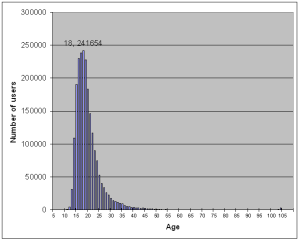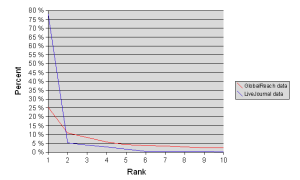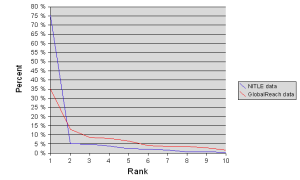One number to rule them all
How many blogs are there? This is one of those questions of incredible interest without any reliable answer. A few companies have been nice enough to provide information that give us some estimate of how large the blogging world is. Unfortunately, most people don’t take the time to decide how reasonable (or not) those numbers are.
A side note… My policy with this website is not to include external links unless those sites are seriously something you should check out. In other words, all these other sites I refer to but don’t link to do exist; I just hope you don’t stumble upon them because they’re useless crap and I don’t want to increase their Google rank inadvertently. Also, for those links I do have, there are probably other places I should have citations for data but I don’t include them because I don’t add multiple links to the same page. Just look around and the data is linked to somewhere else.
Some great data comes from the Pew Internet and American Life Project. One poll that has great blogging results was taken between March to May 2003 with about 1,500 people, making for pretty accurate data. Quick statistics review… The poll had a 3% margin of error with a 95% confidence interval, meaning that there’s a probability — 95% in this case — that their numbers are within 3% of the real numbers, not that any given result is +/-3% of its actual value. Furthermore, the poll was conducted by phone using random phone numbers, meaning the distribution of people who answered the question probably was close to that of the U.S. overall. (Don’t worry about bias from people without phones; they probably don’t have Internet access either.)
Given this fairly accurate poll, Pew reported that about 2% of American Internet users said they have a blog or web diary and about 11% of ‘net users read blogs and web diaries (the data is summarized in their report Content Creation Online). Some people ran with these numbers and found amazing statistics of their own. For example, did you know that 110 million people worldwide read blogs? Well, I didn’t and neither did those 110 million people. I’ll explain…
Let’s say 11% of American Internet users really do read web logs or diaries. And other polls suggest about 200 million Americans (about 2/3 of us) have Internet access from home, work, ‘net cafes, whatever. Do the math and BAM — 22 million Americans read blogs. But then some people take this way too far. Somewhere around 800 million to a billion people worldwide have Internet access, so you multiply 11% by 1 billion ‘net users and 110 million people read blogs. You can do the same math with the number of bloggers and you get about 20 million of them.
110 million blog readers, 20 million blogs, right? Nope, nothing is that simple. Look at LiveJournal’s statistics. By their numbers, more than 35% of LJ’ers are under 18 years old (graph below). Pew missed a significant part of the blogging population by polling only 18-and-ups, and everyone citing that Pew number as absolute truth missed what I think is the most important blogging group there is.
LiveJournal users shown by age. Taken from http://www.livejournal.com/stats/stats.txt. Nov. 12, 2004. The peak of this graph is at 18 years old, and about 36% of users are under 18.
Pew missed the mark by a bit. So how much did they miss it by? I’ll make a few guesses. That 35% of under 18 LJ’ers is probably an underestimate. Half of the people using LJ didn’t bother answering the age part of their profile, and I believe most of those non-responses are under 18. Furthermore, there are liars. You can see a little peak around 104 years old; those people put down their age as being born in 1900. And of course, if you’re going to have a publicly articulated persona, you want to make yourself look as cool as possible, and older is cooler. I’m surprised there aren’t more kids who are 69 years old, but then again how many of them can do the math and figure out they should be born in 1935 for that.
Remember that the Pew study was only about Americans and their Internet use, not the world. If 11% of Americans are doing it, you can be certain that number will not hold for the entire world. While Americans make up about 1/4 of the Internet population, they’re probably a majority of the blogging population. LiveJournal records use by country, and a little under 80% of blog writers are from the U.S. So even if 25% of ‘net users are American, we dominate the blog world. According to the NITLE Blog Census (which I use with caution as I’ll explain later), about 80% of their crawled are written in English, but about 1/3 of all web sites are English and 2/3 of English web sites are in the U.S. Anyone who simply extrapolates global ‘net use to blogging behavior will be off big time.
Graphs of each are below, and the key to the rankings are at the end of this page. Though it would be comparing apples and oranges, the NITLE distribution is almost exactly the same as the LiveJournal data (above). Someday it might be fun to delve deeper into the language/country blog differences, but this is as far as I’ll take it for now.
The top ten countries of total Internet users worldwide (Global Reach) versus LiveJournal users as a percent of the total. (rankings are at the end)
The top ten ranked languages from Internet language data versus NITLE BlogCensus language data as a percent of the total. (rankings are at the end)
One other significant issue is that of definitions. The Pew poll asked if people had read, written, or contributed to a web log, blog, or web diary. I don’t want to digress on such a philosophical problem, but people have different understandings of what a blog or web diary is. Did people say yes about writing a web diary when it was just their family’s web page? Does Slashdot count or not? Who knows. Problems like this always happen, so we’ll have to trust that people know a blog when they see one.
I had a chat with Mary Hodder with Technorati back in October about the big number. (FYI, Technorati deals with all information blog and that’s about it.) She said Technorati estimated the number of blogs to be about 12 million, and that they have over 4 million blogs indexed. BBC News recently had an article where they cited Technorati as saying there are 4.5 million or so blogs in existence. Funny, the BBC number is a lot like the number Mary cited for Technorati’s crawled blogs. I guess you can’t even trust reputable news sources for accurate blogging information.
It gets worse. Other “authorities” for blogging size are cited too often without reflecting on how they got those numbers. NITLE’s Blog Census currently has around 2 million indexed pages. I hope nobody is using their numbers yet. They’ve only gone though less than 5% of the over 5 million LiveJournal blogs (their <5% is less than the number of journals active in the last week). And like I said before, some parts of the sample, such as under 18 bloggers, are only evident in certain domains. Even if NITLE is using a 95% confidence interval, it’s meaningless if they aren’t sampling from the entire population.
Then there are the “other” polls… Most of these I question their methodologies. A few had open online polls, so you have no idea how representative the poll results are of the entire population (like the poll I cited in my last post. Others look only at LiveJournal or similar blog hosting sites without taking into account the non-blog-service-using people. Even with these complaints, at least those polls had enough intelligence to mention these facts along with their poll results.
What does Technorati do that the rest don’t? Their numbers are based on a few things. First, they have web crawlers made specifically for blogs, that use the links in those blogs to find other blogs and add the new ones to their search. They let people submit their blogs to the engine if it’s not already there. They also get “pings” whenever a new blog is created on certain blog hosting sites or when new blog software is installed on an individual’s site. With all this information, the data and estimates they give are probably the most accurate if any are to be trusted.
So how many blogs are there? I have no idea. If I had to wager, I would put my faith in Technorati’s numbers since I trust their methodology the most and since they have much to lose if they’ve got it wrong. Technorati also said (in that same BBC article) that the number of blogs is doubling every 5 1/2 months — 10,000 or so a day, a trend maintained for the last 18 months. That 12 million I cited earlier is probably closer to 15 million blogs now.
I’ll ignore other counting issues like private blogs (as in not publicly accessible), abandoned blogs, and fringe blogs (without incoming links so they can’t be crawled) except to say these make defining what is and is not a blog even more difficult. This stuff is pretty hard to do even with all the data that’s already out there.
Finally, Pew just today came out with some new poll results. 27% of American net users now read blogs — an increase of 58% from February (from political blogs?). Also, Pew says 7% of people now have blogs which is in line with Technorati’s prediction of blogs doubling every 5 1/2 months (comparing Pew’s Mar-May 2003 poll to the new data). That memo is pretty brief though; I’ll wait until there are some methodology details or a full report of their survey data before believing them. Unfortunately, this will not stop people from committing all the same errors I described above and reporting that now 70 million blogs exist and 270 million people read them worldwide. Just wait for it…
That’s enough for now. From here, I’ll get into more detail about blog readers and writers.
Top 10 rankings for the Global Reach country data.
- United States
- China
- Japan
- Germany
- United Kingdom
- Korea
- Italy
- France
- Canada
- Brazil
Top 10 rankings for the LiveJournal country data.
- United States
- Canada
- United Kingdom
- Russian Federation
- Australia
- Germany
- Philippines
- Singapore
- Netherlands
- Japan
Top 10 rankings for the Global Reach language data.
- English
- Chinese
- Spanish
- Japanese
- German
- French
- Korean
- Italian
- Portuguese
- Malay
Top 10 rankings for the NITLE language data.
- English
- French
- Portuguese
- Farsi
- Polish
- German
- Spanish
- Italian
- Dutch
- Chinese (big5)




I would say that PEW, like political pollsters, should definitely start worrying about people without landline phones. That is, especially relevant to blogging, alot of techies have shed their landline phones and gone with cellphones and even VoIP. This introduces a growing (in time) bias against this population, which is especially relevant to blogging as techies are more likely to blog and read blogs (that’s speculation, but not unreasonable).